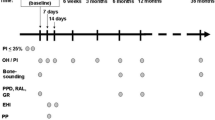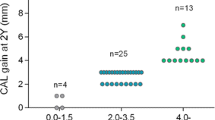Abstract
The aim of this study was to evaluate the 4-year clinical outcomes following regenerative surgery in intrabony defects with either EMD + BCP or EMD. Twenty-four patients with advanced chronic periodontitis, displaying one-, two-, or three-walled intrabony defect with a probing depth of at least 6 mm, were randomly treated with either EMD + BCP (test) or EMD alone (control). The following clinical parameters were evaluated at baseline, at 1 year and at 4 years after regenerative surgery: plaque index, gingival index, bleeding on probing, probing depth, gingival recession, and clinical attachment level (CAL). The primary outcome variable was CAL. No differences in any of the investigated parameters were observed at baseline between the two groups. The test group demonstrated a mean CAL change from from 10.8 ± 1.6 mm to 7.4 ± 1.6 mm (p < 0.001) and to 7.6 ± 1.7 mm (p < 0.001) at 1 and 4 years, respectively. In the control group, mean CAL changed from 10.4 ± 1.3 at baseline to 6.9 ± 1.0 mm (p < 0.001) at 1 year and 7.2 ± 1.2 mm (p < 0.001) at 4 years. At 4 years, two defects in the test group and three defects in the control group have lost 1 mm of the CAL gained at 1 year. Compared to baseline, at 4 years, a CAL gain of ≥3 mm was measured in 67% of the defects (i.e., in 8 out of 12) in the test group and in 75% of the defects (i.e., in 9 out of 12) in the control group. There were no statistically significant differences in any of the investigated parameters at 1 and at 4 years between the two groups. Within their limits, the present results indicate that: (a) the clinical improvements obtained with both treatments can be maintained over a period of 4 years, and (b) in two- and three-walled intrabony defects, the addition of BCP did not additionally improve the outcomes obtained with EMD alone. In two- and three-walled intrabony defects, the combination of EMD + BCP did not show any advantage over the use of EMD alone.
Similar content being viewed by others
References
Wikesjö UME, Selvig KA (1999) Periodontal wound healing and regeneration. Periodontol 2000 19:21–39
Hammarström L, Heijl L, Gestrelius S (1997) Periodontal regeneration in a buccal dehiscence model in monkeys after application of enamel matrix proteins. J Clin Periodontol 24:669–677
Sculean A, Donos N, Brecx M, Reich E, Karring T (2000) Treatment of intrabony defects with enamel matrix proteins and guided tissue regeneration. An experimental study in monkeys. J Clin Periodontol 27:466–472
Gkranias ND, Graziani F, Sculean A, Donos N (2010) Wound healing following regenerative procedures in furcation degree III defects: histomorphometric outcomes. Clin Oral Investig. Oct 22 (in press)
Heijl L (1997) Periodontal regeneration with enamel matrix derivative in one human experimental defect. A case report. J Clin Periodontol 24:693–696
Sculean A, Donos N, Windisch P, Gera I, Brecx M, Reich E, Karring T (1999) Healing of human intrabony defects following treatment with enamel matrix proteins or guided tissue regeneration. J Periodontal Res 34:310–322
Sculean A, Chiantella GC, Windisch P, Donos N (2000) Clinical and histologic evaluation of treatment of intrabony defects with an enamel matrix protein derivative (Emdogain®). Int J Periodontics Restorative Dent 20:375–381
Yukna RA, Mellonig J (2000) Histologic evaluation of periodontal healing in humans following regenerative therapy with enamel matrix derivative. A 10-case series. J Periodontol 71:752–759
Sculean A, Stavropoulos A, Berakdar M, Windisch P, Karring T, Brecx M (2005) Formation of human cementum following different modalities of regenerative therapy. Clin Oral Investig 9:58–64
Bosshardt DD, Sculean A, Windisch P, Pietursson BE, Lang NP (2005) Effects of enamel matrix proteins on tissue formation along the roots of human teeth. J Periodontal Res 40:158–167
Mazjoub Z, Bobbo M, Atiyeh F, Cordioli G (2005) Two patterns of histologic healing in an intrabony defect following treatment with an enamel matrix derivative: a human case report. Int J Periodontics Restorative Dent 25:283–294
Heijl L, Heden G, Svardström G, Östgren A (1997) Enamel matrix derivative (Emdogain®) in the treatment of intrabony periodontal defects. J Clin Periodontol 24:705–714
Pontoriero R, Wennström J, Lindhe J (1999) The use of barrier membranes and enamel matrix proteins in the treatment of angular bone defects. A prospective controlled clinical study. J Clin Periodontol 26:833–840
Froum SJ, Weinberg MA, Rosenberg E, Tarnow D (2001) A comparative study utilizing open flap debridement with and without enamel matrix derivative in the treatment of periodontal intrabony defects: a 12-month re-entry study. J Periodontol 72:25–34
Sculean A, Windisch P, Chiantella GC, Donos N, Brecx M, Reich E (2001) Treatment of intrabony defects with enamel matrix proteins and guided tissue regeneration. A prospective controlled clinical study. J Clin Periodontol 28:397–403
Tonetti MS, Lang NP, Cortellini P, Suvan JE, Adriaens P, Dubravec D, Fonzar A, Fourmousis I, Mayfield L, Rossi R, Silvestri M, Tiedemann C, Topoll H, Vangsted T, Wallkamm B (2002) Enamel matrix proteins in the regenerative therapy of deep intrabony defects. A multicentre randomized controlled clinical trial. J Clin Periodontol 29:317–325
Guida L, Annunziata M, Belardo S, Farina R, Scabbia A, Trombelli L (2007) Effect of autogenous cortical bone particulate in conjunction with enamel matrix derivative in the treatment of periodontal intraosseous defects. J Periodontol 78:231–238
Gurinsky BS, Mills MP, Mellonig JT (2004) Clinical evaluation of demineralized freeze-dried bone allograft and enamel matrix derivative versus enamel matrix derivative alone for the treatment of periodontal osseous defects in humans. J Periodontol 75:1309–1318
Aspriello SD, Ferrante L, Rubini C, Piemontese M (2011) Comparative study of DFDBA in combination with enamel matrix derivative versus DFDBA alone for treatment of periodontal intrabony defects at 12 months post-surgery. Clin Oral Invest 15:225–232
Yamamoto S, Masuda H, Shibukawa Y, Yamada S (2007) Combination of bovine-derived xenografts and enamel matrix derivative in the treatment of intrabony periodontal defects in dogs. Int J Periodontics Restorative Dent 27:471–479
Sculean A, Windisch P, Keglevich T, Chiantella GC, Gera I, Donos N (2003) Clinical and histologic evaluation of human intrabony defects treated with an enamel matrix protein derivative combined with a bovine-derived xenograft. Int J Periodontics Restorative Dent 23:47–55
Lekovic V, Camargo PM, Weinlaender M, Nedic M, Aleksic Z, Kenney EB (2000) A comparison between enamel matrix proteins used alone or in combination with bovine porous bone mineral in the treatment of intrabony periodontal defects in humans. J Periodontol 71:1110–1116
Velasquez-Plata D, Scheyer ET, Mellonig JT (2002) Clinical comparison of an enamel matrix derivative used alone or in combination with a bovine-derived xenograft for the treatment of periodontal osseous defects in humans. J Periodontol 73:433–440
Zucchelli G, Amore C, Montebugnoli L, De Sanctis M (2003) Enamel matrix proteins and bovine porous mineral in the treatment of intrabony defects: a comparative controlled clinical trial. J Periodontol 74:1725–1735
Kuru B, Yilmaz S, Argin K, Noyan U (2006) Enamel matrix derivative alone or in combination with a bioactive glass in wide intrabony defects. Clin Oral Invest 10:227–234
Sculean A, Pietruska M, Arweiler NB, Auschill TM, Nemcovsky C (2007) Four year results of a prospective controlled clinical study evaluating healing of intrabony defects following treatment with an enamel matrix protein derivative alone or combined with a bioactive glass. J Clin Periodontol 34:507–513
Bokan I, Bill JS, Schlagenhauf U (2006) Primary flap closure combined with Emdogain® alone or Emdogain® and Cerasorb® in the treatment of intra-bony defects. J Clin Periodontol 33:885–893
Nery EB, LeGeros RZ, Lynch KL, Lee K (1992) Tissue response to biphasic calcium phosphate ceramic with different ratios of HA/βTCP in periodontal osseous defects. J Periodontol 63:729–735
Jensen SS, Yeo A, Dard M, Hunziker E, Schenk R, Buser D (2007) Evaluation of a novel biphasic calcium phosphate in standardized bone defects. A histologic and histomorphometric study in the mandibles of minipigs. Clin Oral Implants Res 18:752–760
Stein JM, Fickl S, Yekta SS, Hoischen U, Ocklenburg C, Smeets R (2009) Clinical evaluation of a biphasic calcium composite grafting material in the treatment of human periodontal intrabony defects: a 12-month randomized controlled clinical trial. J Periodontol 80:1774–1782
Jepsen S, Topoll H, Rengers H, Heinz B, Teich M, Hoffmann T, Al-Machot E, Meyle J, Jervøe-Storm PM (2008) Clinical outcomes after treatment of intra-bony defects with an EMD/synthetic bone graft or EMD alone: a multicentre randomized controlled clinical trial. J Clin Periodontol 35:420–428
Meyle J, Hoffmann T, Topoll H, Heinz B, Al-Machot E, Jervøe-Storm P-M, Meiß C, Eickholz P, Jepsen S (2011) A multi-centre randomized controlled clinical trial on the treatment of intra-bony defects with enamel matrix derivatives/synthetic bone graft or enamel matrix derivatives alone: results after 12 months. J Clin Periodontol 38:652–660
Armitage GC (1999) Development of a classification system for periodontal diseases and conditions. Ann Periodontol 4:1–6
Löe H (1967) The gingival index, the plaque index and the retention index systems. J Periodontol 38:610–616
Blomlöf JPS, Blomlöf LB, Lindskog SF (1996) Smear removal and collagen exposure after non-surgical root planing followed by etching with EDTA gel preparation. J Periodontol 67:841–845
Gunsolley JC, Elswick RK, Davenport JM (1998) Equivalence and superiority testing in regeneration clinical trials. J Periodontol 69:521–527
Kahldahl WB, Kalkwarf KL, Patil KD, Molvar MP, Dyer JK (1996) Long-term evalution of periodontal therapy: I. Respone to 4 therapeutic modalities. J Periodontol 67:93–102
Tonetti MS, Pini Prato G, Cortellini P (1996) Factors affecting the healing response of intrabony defects following guided tissue regeneration and access flap surgery. J Clin Periodontol 23:548–556
Sculean A, Nikolidakis D, Schwarz F (2008) Regeneration of periodontal tissues: combinations of barrier membranes and grafting materials—biological foundation and preclinical evidence. A systematic review. J Clin Periodontol 35(suppl 8):106–116
Iorio-Siciliano V, Andreuccetti G, Siciliano AI, Blasi A, Sculean A, Salvi GE (2011) Clinical outcome following treatment of non-contained intrabony defects with enamel matrix derivative (EMD) or guided tissue regeneration (GTR). A 12-month randomized controlled clinical trial. J Periodontol 82:62–71
Tonetti MS, Pini-Prato G, Cortellini P (1995) Effect of cigarette smoking on periodontal healing following GTR in infrabony defects. A preliminary retrospective study. J Clin Periodontol 22:229–234
Sculean A, Windisch P, Szendröi-Kiss D, Horváth A, Rosta P, Becker J, Gera I, Schwarz F (2008) Clinical and histologic evaluation of an enamel matrix derivative combined with a biphasic calcium phosphate for the treatment of human intrabony periodontal defects. J Periodontol 79:1991–1999
Source of funding
The study was funded by the author's own institution.
Conflict of interest
The authors declare that they have no conflict of interests.
Author information
Authors and Affiliations
Corresponding author
Rights and permissions
About this article
Cite this article
Pietruska, M., Pietruski, J., Nagy, K. et al. Four-year results following treatment of intrabony periodontal defects with an enamel matrix derivative alone or combined with a biphasic calcium phosphate. Clin Oral Invest 16, 1191–1197 (2012). https://doi.org/10.1007/s00784-011-0611-2
Received:
Accepted:
Published:
Issue Date:
DOI: https://doi.org/10.1007/s00784-011-0611-2




